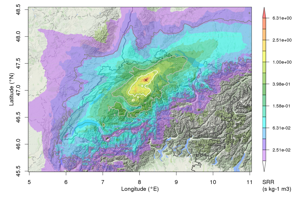FLEXPART for COSMO output
TOGether with MeteoSwiss our group developed a new version of the widely used Lagrangian Particle Dispersion Model (LPDM) FLEXPART for output from the regional numerical weather prediction (NWP) model COSMO. We mainly run FLEXPART-COSMO with operational analysis fields as generated hourly by MeteoSwiss for Western Europe with a horizontal resolution of approximately 7 km x 7 km and a nested grid over the Alpine area with 2 km x 2 km resolution. However, the application of FLEXPART-COSMO is not limited to MeteoSwiss output but can be used with any grib formatted COSMO output that includes a minimal set of variables.
The main differences between FLEXPART-COSMO and standard FLEXPART-ECMWF are the internal vertical grid representation and the parameterisation of convective transport. In FLEXPART-COSMO the native vertical grid of the COSMO model is used as the main frame of reference, whereas standard FLEXPART uses a terrain following height-based vertical coordinate with constant height shifts up to the model top. The latter requires an initial vertical interpolation from model input on pressure-based hybrid coordinates as used in the standard input from ECMWF. In FLEXPART-ECMWF sub-grid scale convection is treated by an Emanuel type scheme. A different parameterisation of convective transport was implemented into FLEXPART-COSMO. In order to stay as close as possible to the convective transport as simulated in COSMO itself, the same modified version of the Tiedtke convection scheme as in COSMO was implemented.
In our group FLEXPART-COSMO is mainly used to calculate high resolution source-receptor relationships for atmospheric surface measurements in the larger Alpine domain (for example those of our high altitude site Jungfraujoch and those of the CarboCount-CH network). The high horizontal resolution used in FLEXPART-COSMO allows for a more realistic description of the complex flow patterns in Alpine terrain that cannot be achieved with standard FLEXPART, which is currently limited to horizontal resolutions of about 20 km x 20 km. Source-receptor relationships give the direct influence of a mass emission from a source location onto the mole fraction at a receptor site. Hence, they can be directly used in inversion emission modeling at the regional scale and the complex Swiss environment.


-
Share

